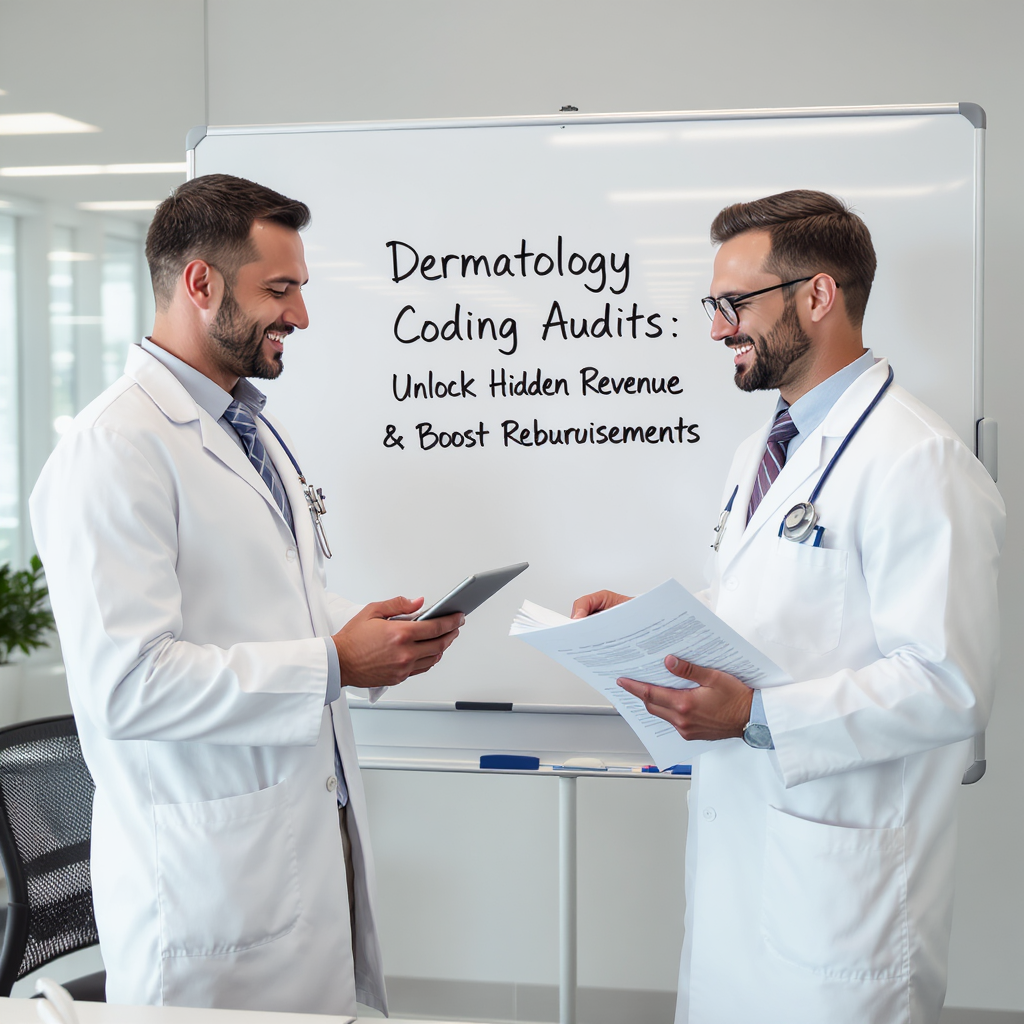Dermatology Coding Audits: Unlock Hidden Revenue & Maximize Your Practice’s Financial Potential
Coding
Coding
In the complex landscape of modern healthcare, where delivering exceptional patient care remains the primary focus, the financial sustainability of your dermatology practice fundamentally depends on one critical yet frequently underestimated factor: medical coding accuracy and optimization. Far too many dermatology practices are unknowingly hemorrhaging substantial revenue due to preventable coding errors, inconsistent documentation practices, and the absence of systematic auditing protocols. This financial drain isn’t merely about compliance or avoiding regulatory penalties—it’s about strategically unlocking hidden revenue streams and ensuring your practice receives every dollar it rightfully deserves for the expert care you provide.

The Silent Revenue Hemorrhage: Understanding Why Dermatology Practices Lose Money
Dermatology billing presents a uniquely complex set of challenges that distinguish it from other medical specialties. The field encompasses an extraordinarily diverse range of procedures—from essential medical interventions like skin cancer screenings and biopsies to elective cosmetic treatments such as laser therapy and chemical peels. This procedural diversity, combined with high patient volumes and frequent minor procedures, creates a perfect storm for coding inaccuracies and revenue leakage.
Primary Revenue Loss Culprits
Systematic Undercoding Patterns Perhaps the most devastating yet subtle form of revenue loss, undercoding occurs when practices consistently bill for lower-complexity services than what was actually provided. This conservative approach, often adopted to avoid potential audits or scrutiny, results in significant undervaluation of your clinical expertise. For instance, billing a level 3 established patient visit (99213) when the documentation clearly supports a level 4 (99214) can cost your practice $50-80 per encounter—a loss that compounds dramatically across thousands of annual visits.
Modifier Misapplication and Omission Modifiers serve as essential coding tools that provide crucial context about procedures, locations, and circumstances. However, their incorrect application or complete omission frequently leads to claim denials, downcoding, or bundling issues. Common dermatology modifier errors include failing to use modifier -25 when performing procedures during evaluation visits, incorrectly applying modifier -59 for distinct procedural services, or missing location-specific modifiers for multiple lesion removals.
Failure to Maintain Current Coding Standards The healthcare coding landscape evolves continuously, with CPT and ICD-10 code updates released annually and payer policies shifting quarterly. Practices that fail to maintain current coding knowledge inevitably experience increased denial rates and delayed payments. New codes for emerging dermatology procedures, updated bundling rules, and revised medical necessity requirements can significantly impact reimbursement if not properly implemented.
Inadequate Documentation Practices The healthcare industry axiom “if it’s not documented, it wasn’t done” carries particular weight in dermatology billing. Insufficient documentation represents one of the most common reasons for claim denials and audit findings. Critical documentation deficiencies include:
- Vague or incomplete diagnostic descriptions
- Missing lesion measurements, locations, and morphology details
- Inadequate medical necessity justification for procedures
- Unclear procedural technique descriptions
- Incomplete patient history and examination findings

Prior Authorization Oversights The increasing prevalence of prior authorization requirements for dermatology procedures creates additional revenue risk. Failing to obtain necessary approvals before service delivery can result in complete claim denials, leaving practices to absorb the cost of services already rendered.
Unresolved Claims and Aging Accounts Receivable Denied claims and aging accounts receivable represent trapped revenue that many practices fail to recover effectively. Industry studies indicate that up to 65% of initially denied claims are never resubmitted, resulting in substantial financial losses that could have been recovered with proper follow-up procedures.
The Strategic Power of Comprehensive Coding Audits
Dermatology coding audits represent far more than routine compliance exercises—they constitute powerful strategic tools capable of transforming your practice’s financial performance and operational efficiency. When executed properly, these audits serve as comprehensive health checks for your revenue cycle, identifying opportunities for improvement and optimization across multiple operational dimensions.
Comprehensive Benefits of Systematic Auditing
1. Revenue Recovery and Optimization Professional coding audits systematically examine your billing practices, identifying patterns of undercoding, missed charges, and uncaptured services. This forensic approach to revenue analysis frequently uncovers substantial hidden revenue streams. Many practices discover 15-25% revenue increases following comprehensive audit recommendations, with some realizing even greater improvements in historically undercoded service areas.
2. Proactive Claim Denial Prevention Rather than reactively addressing denials after they occur, audits enable proactive identification and correction of documentation and coding errors before claim submission. This preventive approach dramatically reduces denial rates, accelerates payment cycles, and minimizes administrative burden on your billing staff. Practices implementing audit-driven improvements typically experience 40-60% reductions in initial denial rates.
3. Reimbursement Accuracy Maximization Audits ensure your practice consistently codes to the highest appropriate level of specificity while maintaining strict adherence to medical necessity requirements and payer guidelines. This optimization process guarantees you receive maximum rightful reimbursement for every service rendered, eliminating the financial impact of conservative undercoding practices.
4. Comprehensive Compliance Assurance Regular auditing ensures your coding practices remain current with evolving regulations from the Centers for Medicare & Medicaid Services (CMS), Office of Inspector General (OIG), and commercial payers. This proactive compliance approach helps prevent costly fines, investigations, recoupment demands, and potential exclusion from federal programs—protecting both your practice’s financial stability and professional reputation.
5. Enhanced Staff Education and Skill Development Beyond error identification, audits provide invaluable educational opportunities for your entire team. Comprehensive audit reports include specific feedback, real-world examples, and targeted training recommendations that address identified knowledge gaps in coding nuances, modifier applications, and documentation standards. This educational component ensures sustainable improvement rather than temporary fixes.

6. Workflow Optimization and Operational Efficiency Audits systematically evaluate your entire revenue cycle, from initial patient registration through final payment posting, identifying bottlenecks, inefficiencies, and process improvement opportunities. Streamlined workflows free valuable staff time for patient care activities while reducing operational costs and improving cash flow velocity.
7. Data-Driven Performance Management Professional audits provide comprehensive analytics and benchmarking data that enable informed decision-making. Key performance indicators such as denial rates, first-pass acceptance rates, average reimbursement per procedure, and payment turnaround times create a foundation for continuous improvement and strategic planning.
Essential Components of Effective Dermatology Coding Audits
Comprehensive Chart Review Process
Effective audits begin with thorough examination of patient charts and associated coding, including:
- CPT Code Accuracy: Verification of procedure code selection against documentation
- ICD-10 Diagnostic Coding: Confirmation of diagnostic specificity and medical necessity support
- Modifier Application: Assessment of appropriate modifier usage and compliance with payer requirements
- Documentation Quality: Evaluation of clinical notes against coding and billing requirements
Payer-Specific Analysis and Benchmarking
Audits must account for varying requirements across different payers:
- Commercial Payer Policies: Review of specific coverage and documentation requirements
- Medicare Guidelines: Compliance with CMS regulations and local coverage determinations
- State Medicaid Requirements: Adherence to state-specific billing and documentation standards
- Industry Benchmarking: Comparison against national and regional performance metrics
Revenue Cycle Assessment
Comprehensive evaluation of your practice’s financial processes:
- Coding Accuracy Rates: Statistical analysis of coding precision across service categories
- Denial Pattern Analysis: Identification of recurring denial reasons and trends
- Payment Velocity Metrics: Assessment of collection timeframes and efficiency
- Accounts Receivable Aging: Evaluation of outstanding balances and collection opportunities
Technology and Process Evaluation
Assessment of systems and workflows supporting accurate billing:
- Electronic Health Record Integration: Evaluation of EHR coding support and automation
- Practice Management System Utilization: Assessment of billing system configuration and usage
- Claim Scrubbing Technology: Review of pre-submission claim validation processes
- Staff Training and Competency: Evaluation of team knowledge and skill levels
Implementation Strategy: Maximizing Audit Value
Establishing Audit Frequency and Scope
Successful practices implement regular audit schedules tailored to their specific needs:
- Annual Comprehensive Audits: Full-scope reviews covering all aspects of coding and billing
- Quarterly Focused Reviews: Targeted assessments of specific service areas or identified issues
- Monthly Monitoring: Ongoing performance tracking and trend analysis
- Real-Time Quality Assurance: Continuous monitoring of coding accuracy and compliance
Creating Actionable Improvement Plans
Effective audits produce specific, measurable recommendations:
- Immediate Corrections: Identification and resolution of acute coding errors
- Process Improvements: Systematic workflow enhancements and policy updates
- Training Programs: Targeted education addressing identified knowledge gaps
- Technology Upgrades: Recommendations for system improvements and automation opportunities
Measuring Success and ROI
Quantifying audit value through key performance indicators:
- Revenue Increase Metrics: Measurement of improved reimbursement following audit recommendations
- Denial Rate Reduction: Tracking improvements in claim acceptance rates
- Compliance Score Improvements: Assessment of regulatory adherence enhancements
- Operational Efficiency Gains: Measurement of workflow improvements and time savings

Conclusion: Investing in Your Practice’s Financial Future
In today’s increasingly complex healthcare environment, proactive dermatology coding management has evolved from an optional best practice to an absolute business necessity. The financial stakes are simply too high, and the competitive pressures too intense, to leave revenue optimization to chance.
By investing in comprehensive, regular coding audits, your dermatology practice can unlock substantial hidden revenue streams, dramatically improve reimbursement accuracy, and establish an unshakeable foundation for long-term financial health and regulatory compliance. The question isn’t whether you can afford to implement systematic auditing—it’s whether you can afford not to.
Don’t allow another day of valuable revenue to slip through preventable coding gaps. Take control of your practice’s financial destiny through strategic, data-driven coding optimization. Your investment in professional auditing services will pay dividends not only in immediate revenue recovery but in sustainable, long-term practice growth and financial security.



